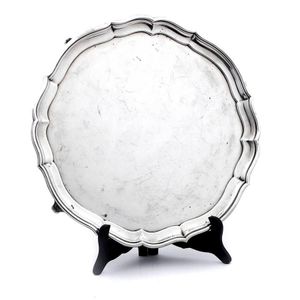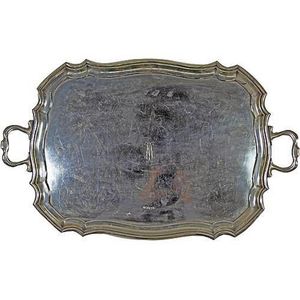Unmarked Sterling Silver Clover Salver, 35cm Diameter
You must be a subscriber, and be logged in to view price and dealer details.
Subscribe Now to view actual auction price for this item
When you subscribe, you have the option of setting the currency in which to display prices to $Au, $US, $NZ or Stg.
- Hallmarks - A mark stamped on articles of precious metals in Britain, since the 14th century, certifying their purity. It derives its name from the Guild Hall of the Goldsmiths' Company, who recieved its Charter in 1327 giving it the power to assay (test the purity) and mark articles of gold and silver.
The hallmark will consist of several marks, including the:
- silver standard mark, indicating the purity of the metal. Sterling silver is .925 pure silver.
- the city mark indicating the city in which it was assayed eg London, Birmingham, York etc.
- the date mark, usually a letter of the alphabet in a particular font and case,
- a duty mark, indicating whether duty had been paid to the crown, and only in use from 1784 to 1890
The piece may include an additional mark, the maker's mark, although not forming part of the hallmark, will be located in the vicinity of the hallmarks.
Sometimes silver plated items will bear faux hallmarks, often confusing those not familiar with silver markings. - Sterling Silver - Sterling silver is a mixture of 92.5% pure silver and 7.5% of another metal, usually copper. Fine silver is 99.9% pure silver, and is relatively soft and the addition of the very small amount of copper gives the metal enough strength and hardness to be worked into jewellery, decorative and household objects.
- Salver - A plate or tray used for the formal offering of food, drink, letters or visiting cards, usually of silver plate, silver or silver-gilt. Large, heavy, oblong or oval silver salvers evolved into what we know as trays in the 18th century. Small, flat salvers are known as waiters.
This item has been included into following indexes:
Visually similar items

A George VI sterling silver circular salver by Elkington & Co, 1939, 35 cm diameter 1185grams

An old wooden platter, on purpose built stand, used to present cone shells (new mwali) to Kaileuna Chiefs at end of the communal cone fishing competiton Vinau, purchased from Chief Katubai on Kaileuna Island, Trobriand Islands Papua New Guinea, mentioned i

English hallmarked sterling silver Edward VIII double handled tray of shield form, with inscribed monogram 'Wn'. Sheffield, 1936, maker Hardy Brothers length 62 cm weight 2706g

A Limoges porcelain wall plate painted with courtship figure in 18th century costume; gilt edged. Diameter 40 cm
